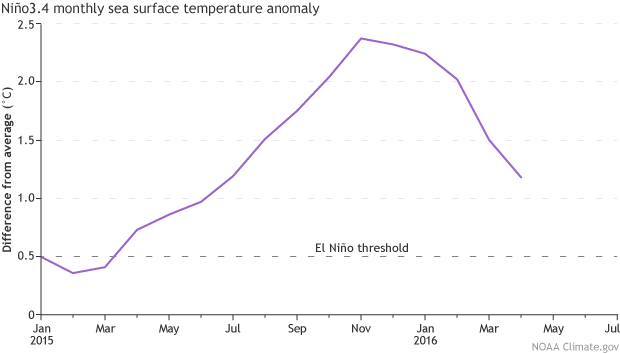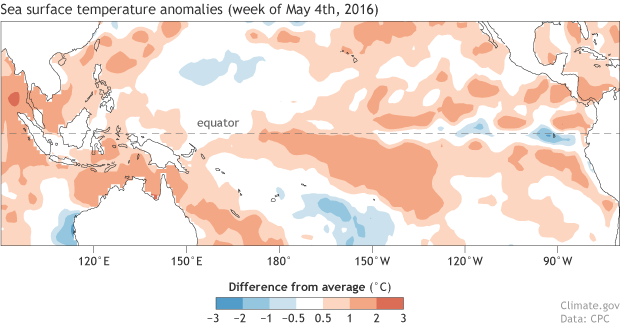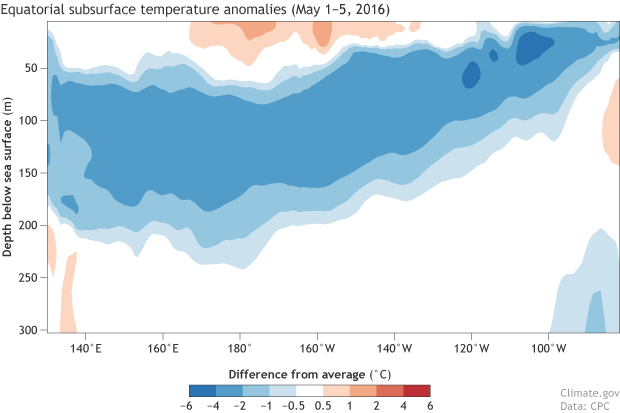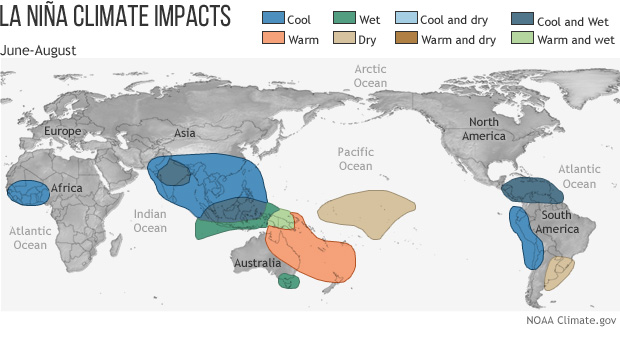
May 2016 El Niño/La Niña update: Switcheroo!
by Emily Becker/NOAA on May 11th, 2016
There’s a 75% chance that La Niña will be in place by the fall, meaning sea surface temperatures in the central Pacific at the equator will be more than 0.5°C below average. It’s possible the transition from El Niño to La Niña will be quick, with forecasters slightly favoring La Niña developing this summer. What’s behind this reasonably confident forecast?
Current conditions
Sea surface temperatures in the Nino3.4 region, our primary index for ENSO (El Niño/Southern Oscillation), have been cooling steadily since they peaked at 2.4°C (4.3°F) above average back in November. Recently, cooling has accelerated, and April was 1.2°C above average using ERSSTv4, our most historically consistent sea surface temperature dataset from NOAA NCEI.

Monthly sea surface temperature in the Niño 3.4 region of the tropical Pacific compared to the 1981-2010 average. Temperatures have been falling rapidly since late winter. Climate.gov graph based on ERSSTv4 temperature data.
However, this is still well above the El Niño threshold of 0.5°C above average, and the atmosphere is still responding to those warmer surface temperatures. Both the Equatorial Southern Oscillation Index and the traditional Southern Oscillation Index were still negative in April, meaning the surface pressure in the western Pacific is still higher than average, while the surface pressure in the eastern Pacific is lower than average—evidence of a weakened Walker Circulation. (For a refresher on why we have so many different indexes for tracking ENSO, see Tony’s previous post.)
Despite these lingering signs of El Niño, the trend toward neutral conditions (Nino3.4 SST within 0.5°C of average) is very likely to continue. Most computer models are predicting El Niño conditions will come to an end in the early summer, and that sea surface temperatures will continue to drop, potentially passing the La Niña threshold (0.5°C below average) sometime in the summer. Some areas of near- or below-average sea surface temperatures have already appeared in the eastern Pacific.

Sea surface temperatures during the week of May 4, 2016, compared to the 1981-2010 average. A few pockets of cool water have appeared in the eastern tropical Pacific (image right). Climate.gov figure by Fiona Martin, from CPC data.
Big blue blob
Along with the computer models, another feature that is lending confidence to the forecast for a La Niña is the amount of cooler-than-average water under the surface of the Pacific. This large pool of cool water stretches across the entire Pacific, along the Equator, and extends down from just below the surface to around 500 feet.

Cross-section of the equatorial Pacific Ocean for May 1-5, 2016, showing subsurface temperature (0-300 meters) compared to the 1981-2010 average. A large area of water that was 2-4 degrees Celsius cooler than normal had pooled up beneath the surface at depths of around 100-200 meters. Climate.gov figure by Fiona Martin, from CPC data.
During this past March–April, the average temperature in this part of the subsurface ocean was the second-coolest on record (records start in 1979). The coldest on record? March–April 1998, immediately following the strong El Niño event of 1997-98. Colder subsurface ocean water during the spring has a strong association with La Niña. La Niña winters followed all of the six springs with the coolest temperature anomalies (Thanks to Yan Xue of CPC for the tip!)
Fun facts
There are 14 La Niña events in our historical record, going back to 1950. (There are 23 El Niño events in the same record). To qualify as a La Niña event, the three-month-average sea surface temperature in the Niño3.4 region (the Oceanic Niño Index) must remain at least 0.5°C below the long-term average for five or more overlapping three-month periods.
Like El Niño, La Niña tends to peak in the late fall/early winter. Peak La Niña temperature anomalies (anomaly = departure from long-term average) do not tend to be quite as big as peak anomalies during El Niño, with the strongest on record being -1.9°C during November–January 1973/74. For reference, the 1997/98 El Niño and this past winter’s El Niño peaked at 2.3°C.
Of those 14 La Niñas, nine immediately followed El Niño years. Two occurred two years after an El Niño, with a neutral year intervening. Two were the second year of a “double dip” La Niña, where sea surface temperatures briefly returned to neutral during the summer before heading back into La Niña territory (1974/75 and 2011/12). The remaining one starts the records off in 1950.
In short, all La Niña events in our record have started within two years of an El Niño. (But not all El Niño events are followed by La Niña.) El Niño does not have a similar rule, as several of the 23 El Niños on record have started four or more years after the last La Niña.
La Niña events often last longer than El Niño events. Only once on record has El Niño lasted through two straight winters, 1986-1988, but it has happened with La Niña three times. The La Niña event that followed the 1997/98 El Niño lasted for thirty-three months, through three winters!
Weather wise
During July – August, La Niña has limited impacts on the northern hemisphere weather, with the exception of the hurricane season (it can contribute to a less active Pacific, more active Atlantic). There are some typical effects in the southern hemisphere during this season.

Typical rainfall and temperature patterns in the Northern Hemisphere summer during La Niña events. Most of the impacts are confined to the tropics and the Southern Hemisphere sub-tropics. These patterns become more likelyduring La Niña events, but they are not guaranteed. NOAA Climate.gov map.
Over the next few months, we’ll get into the effects we can expect during a La Niña winter, as well as some of the how and why. Stay tuned!
2 thoughts on “NOAA’s Official May La Nina Update: Everything You Need To Know About The Coming La Nina”